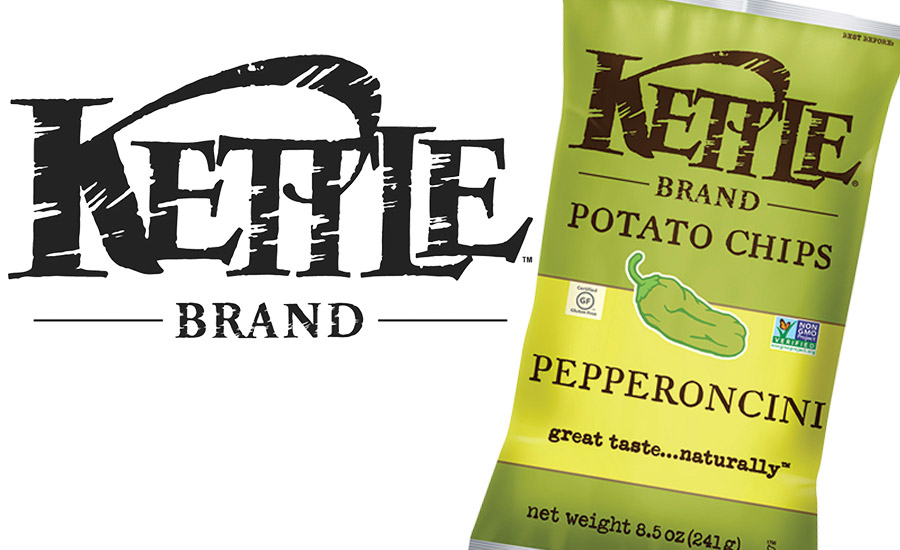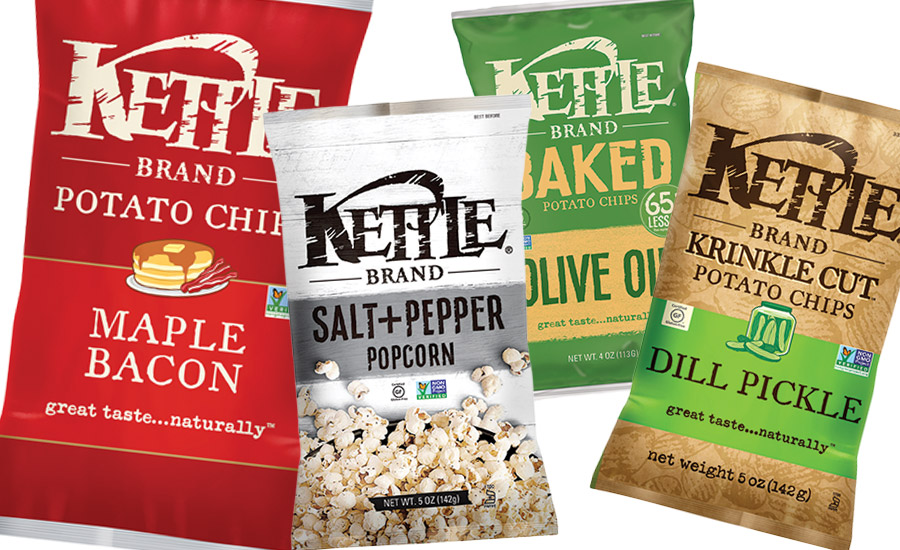Natural chip leader Kettle Brand continues innovation

Kettle Brand

Kettle Brand

Kettle Brand



The entrance to the Diamond Foods Kettle Brand facility in Salem, OR—manufacturers of the leading natural kettle chips in the U.S.—features a display of artistic renderings of the brand’s ideological underpinnings―commitments to freshness, clean label, natural foods and sustainability—and a dedication to the state of Oregon.
“Painted on the wall here, you’ll see messages that reflect our values,” says Marc McCullagh, senior brand manager, Kettle Brand, Diamond Foods Inc. “And these values haven’t changed from the time our brand was founded to where we are today.”
Kettle Brand’s identity extends into the principles held by the brand’s founder, Cameron Healy, a food-industry entrepreneur with deep roots in Oregon and the natural-foods industry. After finding beautiful inspiration sampling homemade potato chips on a beach in Hawaii, he began experimenting with industrial manufacturing processes, developed a better potato chip, and began selling it out of the back of a van in 1982. Within a few short years, Kettle Brand chips had developed a loyal, international following.
Healy later sold Kettle Foods to a private-equity group in 2006, which subsequently sold to Diamond Foods in 2010. Then, in October, Snyder’s-Lance Inc. entered into a definitive agreement to acquire all outstanding shares of Diamond Foods in a cash and stock merger transaction. At press time, completion of the transaction was still subject to approval by both Snyder’s-Lance and Diamond Foods stockholders.
“A lot has changed since we perfected that first golden chip, but the core values of the brand have stayed the same,” says McCullagh.
But Kettle Brands is more than just snacks. “It’s what we can do with our communities,” says McCullagh. “It’s living alongside nature and allowing commerce and nature to coexist as one. That was a big principle of our founder, and that’s something we continue today.”
Natural brand identity
Kettle Brand is known for its premium kettle-cooked chips, baked chips and ready-to-eat (RTE) popcorn. “We also have a few other innovations in the pipeline,” says McCullagh. “This December, we’ll begin shipping two new lines to retailers: kettle-cooked potato chips made with avocado oil and infused salts, as well as a new line of vegetable chips.” The new line of vegetable chips is dubbed Kettle Brand Uprooted.
Kettle Brand is a home to notable flavor innovation, and the team has seen demand for pickled flavors increase. “To keep up with this trend, we launched Krinkle Cut Dill Pickle Chips in August 2015 and Pepperoncini Chips in December 2014,” says McCullagh. Sriracha chips and RTE popcorn also hit the market in 2014. These bold flavors have found strong followings, he reports, but the classics remain strong. “Our Sea Salt Chips, Sea Salt & Vinegar Chips and Salt & Fresh Ground Pepper Chips continue to be best-sellers.”
Other new flavors include Carolina BBQ, Roasted Garlic and Red Curry. “Americans are more open to incorporating globalized and multidimensional flavors in their diet,” says McCullagh. “We have several other product innovations in the pipeline slated to come out next year.”
During R&D, Kettle Brand formulators use flavor metrics of real foods as “guardrails” to keep them on track, as well as “pivot points” to ensure that the resultant product maintains strong relevancy for the brand. “I think the key aspect that makes us stand apart is that the flavors of our chips really taste true to the real food,” says Carolyn Ottenheimer, senior director of research & development and chief flavor architect.
“When we as a brand decided a few years ago that the sweet and savory flavor trend was something that was right for potato chips, we wanted to be on the forefront of it,” says McCullagh. “We decided collectively that maple bacon was an interesting flavor.” So the R&D team came back with dozens of different types of maple syrup, including multiple regional varieties of pure maple syrup. “The goal was to find exactly the right maple,” he says.
“We have different strategies for each retail channel,” says McCullagh. “Our Thick + Bold line was developed for the convenience channel, with even bolder flavors and unique packaging aimed at a younger, male consumer.”
Packaging often sees a bold touch, as well. “After an initial launch in late 2014, we reintroduced our RTE popcorn in new packaging in spring 2015 with a bold, bright revamp, which aligns more with the look and feel consumers are used to seeing in our core line of chips,” says McCullagh. “We did the same with the Baked line just this summer, helping to increase brand recognition for this product line.”
A spirit of innovation
Diamond Foods recently unveiled a new, state-of-the-art, 7,000-square-foot Innovation Center adjacent to its original Salem plant to house R&D for all company brands, including flavors, formats and packaging, for Kettle Brand, Pop Secret, Emerald and Diamond of California products. The kitchen can do small batch runs replicating some plant cooking processes. The center also houses sensory testing and features a multipurpose meeting space and innovation studio dubbed “The Nosh Pit.”
Holly Mensch, senior vice president, innovation, research & development, notes that locating the facility in Oregon was partially a strategic move due to the state’s lively food culture. “There’s a lot of inspiration here,” she says. It’s also a leading area for environmental sustainability initiatives. “It forces you to think a little bit differently.”
Mensch calls the center a “design house” that destroys “siloed” approaches to product development. “We put all these people that are involved in designing the product together in one space, under one leader, so that we are designing everything up front,” she says. It’s home to a cross-functional team of marketers, packaging engineers, sensory scientists, food scientists and regulatory specialists.
“This has enabled us to hear the voice of all the disciplines at the front end of the process,” says Ottenheimer. “In addition, the voice of manufacturing, procurement and quality assurance are all considered, since they sit right next door in the Kettle Brand plant facility.”
The center hosts focus groups and consumer sensory product testing. “The new center can be a game-changer and will enable us to maximize the front-end innovation process,” says Ottenheimer. “We will be closer to the consumers at every step along the development process. This will enable us to get real-time feedback on the concept, the product and the packaging that can be acted on immediately.
Kettle Brands has also formed a “Tastemakers Panel” composed of people on the forefront of food trends. “We have a farmer,” says Mensch. “We have some chefs, some nutritionists. We have cookbook authors, a food blogger, a brewmaster. We run ideas by them at an early stage. We want these people to help push us to think differently.”
 Operational dynamics
Operational dynamics
Kettle Brand operates two production facilities in the U.S., both of which are SQF-certified. “Our first factory opened in Salem, OR, back in the early 1980s,” says McCullagh. “It produces kettle-cooked chips and baked chips. In 2007, we opened another facility in Beloit, WI, which makes kettle-cooked chips and Reduced Fat Chips. Our new vegetable chips will be made at both locations.” A facility in Norwich, England, manufactures products for the European market.
Kettle Brand has earned Non-GMO Project verification on 35 products in the past five years, including all new product introductions. All organic products are certified by Oregon Tilth.
The Salem plant receives an average of 500,000 pounds of potatoes a day, with most coming from Eastern Washington. The potatoes, while already prewashed, get an additional wash once delivered to the facility. Sorters and optical lasers cull any potatoes not within specifications. Automating the sorting process has yielded significant savings and improved throughput. While the potatoes are scoured during the cleansing process, they aren’t peeled. “The peel is part of the texture and flavor of the chip,” says Kirk Jensen, senior vice president, manufacturing, engineering & quality.
“We’ll fry the chips for 8–10 minutes per batch,” says Jensen. “We want to get it down to a certain temperature to give us what we believe is the Kettle Brand texture, bite and curl.” The kettle-chip frying process is mostly automated, with the exception of a line member who gives the chips a manual stir here and there as a quality-control check. “You could fully automate it, but we like to have someone around keeping an eye on it.” The target moisture content for the chips is 2 percent.
After frying, the kettle chips pass under optical and laser sorters to remove any defective or out-of-spec chips. The conveyor system also sizes the chips for packaging in smaller or larger bags. In keeping with Kettle Brand’s zero-waste goals, all defective product sees repurposing in products like livestock feed or biofuel. Nothing goes to the landfill.
Tumblers season the chips, feeding the form/fill/seal bagging system. The facility has begun automating case packing, with the goal of eventually automating the entire end of the line, including palletizing.
Growth continues. The Salem facility will add new fryers in the coming year. All equipment on the line will be isolated, notes Jensen, from handling to packing. That will enable the plant to have an organic product run alongside a conventional run, or a specialty oil alongside a conventional run, he says.
As shoppers continue to display changing preferences for specialized products, such degrees of flexibility can make all the difference.
Looking for a reprint of this article?
From high-res PDFs to custom plaques, order your copy today!









